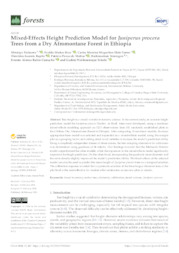Mixed-effects height prediction model for Juniperus procera trees from a Dry Afromontane Forest in Ethiopia.
Mixed-effects height prediction model for Juniperus procera trees from a Dry Afromontane Forest in Ethiopia.
Autoria: TESHOME, M.; BRAZ, E. M.; TORRES, C. M. M. E.; RAPTIS, D. I.; MATTOS, P. P. de; TEMESGEN, H.; RUBIO-CAMACHO, E. A.; SILESHI, G. W.
Resumo: Tree height is a crucial variable in forestry science. In the current study, an accurate height prediction model for Juniperus procera Hochst. ex Endl. trees were developed, using a nonlinear mixed-effects modeling approach on 1215 observations from 101 randomly established plots in the Chilimo Dry Afromontane Forest in Ethiopia. After comparing 14 nonlinear models, the most appropriate base model was selected and expanded as a mixed-effects model, using the sample plot as a grouping factor, and adding stand-level variables to increase the model’s prediction ability. Using a completely independent dataset of observations, the best sampling alternative for calibration was determined using goodness-of-fit criteria. Our findings revealed that the Michaelis–Menten model outperformed the other models, while the expansion to the mixed-effects model significantly improved the height prediction. On the other hand, incorporating the quadratic mean diameter and the stem density slightly improved the model’s prediction ability. The fixed-effects of the selected model can also be used to predict the mean height of Juniperus procera trees as a marginal solution. The calibration response revealed that a systematic selection of the three largest-diameter trees at the plot level is the most effective for random effect estimation across new plots or stands.
Ano de publicação: 2024
Tipo de publicação: Artigo de periódico
Unidade: Embrapa Florestas
Observações
1 - Por padrão são exibidas publicações dos últimos 20 anos. Para encontrar publicações mais antigas, configure o filtro ano de publicação, colocando o ano a partir do qual você deseja encontrar publicações. O filtro está na coluna da esquerda na busca acima.
2 - Para ler algumas publicações da Embrapa (apenas as que estão em formato ePub), é necessário ter, no celular ou computador, um desses softwares gratuitos. Sistemas Android: Google Play Livros; IOS: iBooks; Windows e Linux: software Calibre.
Acesse outras publicações
Acesse a Base de Dados da Pesquisa Agropecuária (BDPA) para consultar o acervo completo das bibliotecas da Embrapa.

